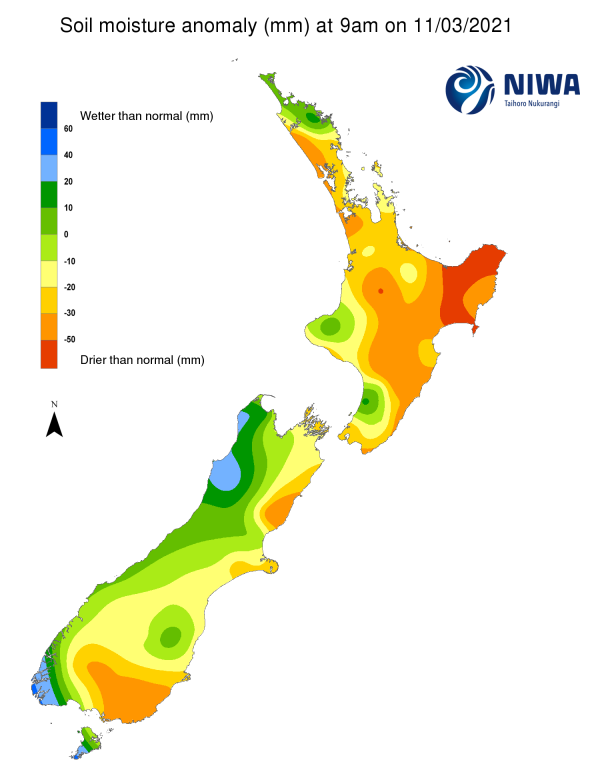A weekly update describing soil moisture patterns across the country to show where dry to extremely dry conditions are occurring or imminent. Regions experiencing significant soil moisture deficits are deemed “hotspots”. Persistent hotspot regions have the potential to develop into drought.
Facts: soil moisture
In the North Island, meagre rainfall was observed nearly everywhere during the past week, with most locations receiving less than 10 mm. However, parts of Gisborne fared slightly better with up to 20 mm of rainfall. This resulted in small soil moisture decreases across most of the North Island, although minor increases were observed in Gisborne. The driest soils across the North Island, when compared to normal for this time of the year, are found from East Cape to eastern Bay of Plenty, while the wettest soils for this time of the year for the North Island are found near Kapiti Coast.
Hotspot conditions are currently found in southern Northland, parts of Auckland, far northern Waikato, parts of East Cape, southern Hawke’s Bay to Wairarapa, interior Manawatū-Whanganui, and the area around Wellington City. The New Zealand Drought Index (NZDI) map below shows that widespread dry to very dry conditions are in place across most of the central and eastern North Island.
In the South Island, moderate to heavy rainfall was observed across western Tasman, the West Coast, and Fiordland, with widespread amounts of 50-75 mm, and isolated amounts of 100 mm or more. While up to 25 mm was observed in coastal Southland, only minimal rainfall fell from Marlborough to Otago. This led to small soil moisture decreases across most of the South Island, although the West Coast saw little change. The driest soils in the South Island compared to normal for this time of year are located in coastal Hurunui District, while the wettest soils for this time of the year for the South Island are found in Fiordland and Buller District.
Hotspots are currently in place across much of eastern Marlborough, northern Canterbury, Banks Peninsula, coastal Selwyn District, and coastal Otago south of Dunedin. The New Zealand Drought Index (NZDI) map below shows that widespread dry to very dry conditions are in place across the northeastern South Island as well as parts of Otago and Southland.
Outlook and soil moisture
High pressure will control the North Island’s weather throughout the next week or so, which will lead to minimal rainfall totals for most locations. However, an onshore wind flow will result in occasional light to moderate showers in Hawke’s Bay and Gisborne during much of next week. While weekly rainfall totals in Hawke’s Bay and Gisborne could reach 15-25 mm, the remainder of the North Island will receive less than 10 mm, with some areas receiving no rainfall at all.
Due to the meagre weekly rainfall, additional soil moisture decreases are expected across a majority of the North Island during the next week. However, little change is expected in Hawke’s Bay and Gisborne. The current hotspots in the North Island are likely to further strengthen during the next week.
The same area of high pressure will also affect the South Island during the next week, with very little rainfall expected. In fact, nearly all locations will receive less than 10 mm in the next week, with the exception of the lower West Coast and Fiordland where amounts may reach 20 mm.
Due to the expected weekly rainfall, further soil moisture decreases are likely across nearly all of the South Island. All current hotspots are expected to strengthen and expand during the next week.
Background
Hotspot Watch: a weekly advisory service for New Zealand media. It provides soil moisture and precipitation measurements around the country to help assess whether extremely dry conditions are imminent.
Soil moisture deficit: the amount of water needed to bring the soil moisture content back to field capacity, which is the maximum amount of water the soil can hold.
Soil moisture anomaly: the difference between the historical normal soil moisture deficit (or surplus) for a given time of year and actual soil moisture deficits.
Definitions: “Extremely” and “severely” dry soils are based on a combination of the current soil moisture status and the difference from normal soil moisture (see soil moisture maps).
Hotspot: A hotspot is declared if soils are "severely drier than normal" which occurs when Soil Moisture Deficit (SMD) is less than -110 mm AND the Soil Moisture Anomaly is less than -20 mm.
Soil Moisture Anomaly Maps, relative to this time of year. The maps show soil moisture anomaly for the past two weeks.
As of 17 March, the New Zealand Drought Index (NZDI) map below shows that widespread dry to very dry conditions are in place across most of the central and eastern North Island, northeastern South Island, as well as parts of Otago and Southland. However, meteorological drought is not currently found in New Zealand. Please note: some hotspots in the text above may not correspond with the NZDI map. This difference exists because the NZDI uses additional dryness indices, including one which integrates the rainfall deficit over the past 60 days. Changes are therefore slower to appear in the NZDI compared to soil moisture anomaly maps that are instantaneously updated.




